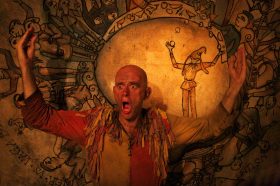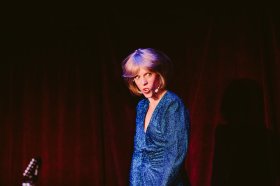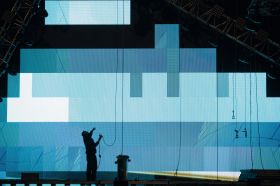In Becoming Eliza, soprano and actor Anna O’Byrne reflects – through story and song, accompanied by live music – on her experience of being chosen by Dame Julie Andrews to play Eliza Doolittle in the 60th Anniversary production of My Fair Lady in 2016, a role for which she won a Helpmann Award.
Andrews famously first performed the role of Eliza Dolittle in the 1956 Broadway premiere of My Fair Lady, and – perhaps infamously – was not invited to play the role in the 1964 film. Warner Brothers studio boss Jack Warner wanted someone with bigger star power, so Audrey Hepburn was cast. For modern audiences familiar with the film, it may seem difficult to imagine another actor in the role, but at the time, casting Hepburn was considered a controversial decision. Not least because she wasn’t a singer, but also because Andrews’ Eliza was the Eliza.
But Becoming Eliza, written and performed by Anna O’Byrne, is not about Hepburn’s Eliza – it’s all about O’Byrne and Andrews.
Becoming Eliza premiered at the Sydney Opera House in 2022 before touring Australia. I saw it in Melbourne’s historic Comedy Theatre. Peppered with songs made famous by Andrews, O’Byrne lets us into the experience of crossing the world to audition in front of Andrews, the nail-biting wait to hear the news (‘I Have Confidence’ from The Sound of Music), the bitter first disappointment in not being selected, followed by an unexpected additional meeting with Andrews that eventually led her to get the part (‘I Could Have Danced All Night’ from My Fair Lady). O’Byrne tells us about the challenges of embodying such an iconic role, under the tutelage of the very person who made it famous on Broadway in its original 1956 production.
O’Byrne’s bearing, voice and character exudes some fundamental Julie Andrews-esque essence that makes it clear why she was chosen for the role of Eliza by Andrews. But, as the performance is so much about life imitating art and vice versa, it’s not clear whether this likeness of style predated O’Byrne’s casting or was a result of becoming so enmeshed in the world of Eliza Doolittle as directed by Eliza’s first animating force.
Whatever the case, O’Byrne possesses the same forthright character and wholesome charm of Andrews, the same – as she says – ‘warm vowels and crisp consonants’ she learned from Andrews in rehearsal and, gosh, does she know how to draw an audience into her story. The empathetic oohs and ahhs and ahas from the audience are clear-cut evidence she has everyone in the theatre in the palm of her hand.
And it is an exciting story: a young actor on the brink of destitution living in the UK, plucked from obscurity by a world-famous Dame into the title role of a major musical production – and then the struggle with the role, embodying and finding the Eliza within, and the huge shoes she feels she must fill. This is the art-imitating-life-imitating-art at the heart of the story.
As a parallel, it’s a successful one (who doesn’t love a rags-to-riches story?) and O’Byrne makes the link clear throughout. In a short history lesson told through the use of large prop cards on an easel, she explains how the 1956 musical My Fair Lady was inspired by the 1913 George Bernard Shaw play Pygmalion, itself inspired by the story of the sculptor Pygmalion who fell in love with Galatea, a statue he had carved – which first appeared in Ovid’s Metamorphoses.
O’Byrne takes us through the experience of rehearsing for My Fair Lady, and the challenge she had with the Ascot scene – the ‘come on Dover, move your bloomin’ a**e’ one – where Eliza drops back into her natural Cockney accent in her first public outing at the very posh Ascot Races. By her own admission she found it difficult as she was mimicking Andrews’ Eliza, not finding Eliza herself. To truly become Eliza she needed to strip all artifice, a sculpture emerging from the marble.
As a hero’s journey about art, character and creation, and what’s real and what’s not, Becoming Eliza is smart, charming, heart-warming and beautifully told. O’Byrne’s soprano voice is gorgeous and the songs add depth and humour to the storytelling. The musical direction – by Michael Tyack on the night I saw it – is on point, with piano and string ensemble working seamlessly with O’Byrne to tell her story. The one slight technical issue was O’Byrne’s switching between radio mic’ed amplification and an on-stage mic, which seemed to pick up her plosives a tad heavily as she sang.
Although modern audiences will find a number of problematic issues with the story of My Fair Lady (the sheer number of insults Henry Higgins flings at Eliza throughout is enough to fill up a roll of parchment – as O’Byrne proves), as well as its historical predecessors, O’Byrne’s own modern, one-woman interpretation and realisation of the story finds what it is at the heart of the ancient tale that we, as an audience, keep coming back to.
Read: Book review: Broke, Sam Drummond
And O’Byrne, like Eliza Doolittle, has all the charisma and chutzpah to keep us enthusiastically on her side.
Becoming Eliza
Written and performed by Anna O’Byrne
Comedy Theatre, Melbourne
Director: Sharon Millerchip
Musical Director: Michael Tyack, Guy Simpson
Ensemble musicians: Roy Theaker (violin), Kalina Krusteva (cello), Katri Tuomennoro (double bass)
Sound designer: Julian Spink
Lighting designer: Peter Rubie
Stage Manager: Andrew Cutts
Producer: Enda Markey
Becoming Eliza was performed at Melbourne’s Comedy Theatre on 26 August, 2023 and will be touring to Geelong Arts Centre on 22 November 2023.





